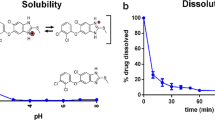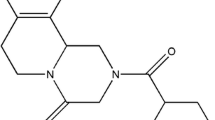Abstract
Solids dispersions (SDs) have been proposed as an alternative to improve the dissolution rate of low solubility drugs. SDs containing albendazole (ABZ; 5, 10, 25, and 50% w/w) and Pluronic 188 (P 188) as hydrophilic carrier were formulated. The obtained SDs were assessed in comparison to physical mixtures (PMs). Drug–polymer interactions in solid state were investigated using Fourier-transform infrared spectroscopy, scanning electron microscopy, and X-ray diffraction analysis. No chemical interaction was found between ABZ and poloxamer. The dissolution profiles indicated that ABZ incorporated in SDs and PMs was rapidly released, reaching rapidly the steady state. Increased dissolution rates are usually observed at the highest polymer proportions. However, an opposite effect for SDs as well as for PMs was observed in the assays described here. The systems with the lowest P 188 percentages (SD4, SD3; PM4, PM3) tended to be more effective in increasing the ABZ dissolution rate. Such a result can be attributed to the fact that concentrated aqueous solutions of Poloxamer may form thermo-reversible gels. The physical–mechanical properties indicated that SDs possess improved flow and compacting properties compared to PMs. Thus, ABZ SDs would be more convenient for solid dosage form design and manufacture.





Similar content being viewed by others
References
Leuner C, Dressman J. Improving drug solubility for oral delivery using solid dispersions. Eur J Pharm Biopharm. 2000;50(1):47–60.
Amidon GL, Lennernnas H, Shah VP, Crison JR. A theoretical basis for a biopharmaceutic drug classification: the correlation of in vitro drug 410 product dissolution and in vivo bioavailability. Pharm Res. 1995;12:413–20.
Georgarakis E, Sigalas MP, Avgoustakis K, Bikiaris D, Karava E. Investigation of the release mechanism of a sparingly water-soluble drug from solid dispersions in hydrophilic carriers based on physical state of drug, particle size distribution and drug–polymer interactions. Eur J Pharm Biopharm. 2007;66:334–47.
Sekiguchi K, Obi N. Studies on absorption of eutectic mixture. II. Absorption of fused conglomerates of chloramphenicol and urea in rabbits. Chem Pharm Bull. 1964;12:134–44.
Levy G. Effect of particle size on dissolution and gastrointestinal absorption rates of pharmaceuticals. Am J Pharm Sci Support Public Health. 1963;135:78–92.
Kanig JL. Properties of fused mannitol in compressed tablets. J Pharm Sci. 1964;53:188–92.
Janssens S, de Novoa Armas H, Roberts CJ, Van den Mooter G. Characterization of ternary solid dispersions of Itraconazole in polyethylene glycol 6000/polyvidone-vinylacetate 64 blends. Eur J Pharm Biopharm. 2008;69(3):1114–20.
Wang X, Michoel A, Van den Mooter G. Study of the phase behavior of polyethylene glycol 6000–itraconazole solid dispersions using DSC. Int J Pharm. 2004;272(1–2):181–7.
Konno H, Handa T, Alonzo DE, Taylor LS. Effect of polymer type on the dissolution profile of amorphous solid dispersions containing felodipine. Eur J Pharm Biopharm. 2008;70(2):493–9.
Marín MT, Margarit MV, Salcedo GE. Characterization and solubility study of solid dispersions of flunarizine and polyvinylpyrrolidone. Farmaco. 2002;57(9):723–7.
Vasconcelos T, Sarmiento B, Costa P. Solid dispersions as strategy to improve oral bioavailability of poor water soluble drugs. Drug Discov Today. 2007;12:1068–75.
Collett JH, Popli H. Poloxamer. In: Kibbe AH, editor. Handbook of Pharmaceutical Excipients. London; 2000. p. 385–388.
Zhai H, Li S, Andrews G, Jones D, Bella S, Walker G. Nucleation and growth in fluidised hot melt granulation. Powder Technol. 2009;189(2):230–7.
Vilhelmsen T, Eliasen H, Schaefer T. Effect of a melt agglomeration process on agglomerates containing solid dispersions. Int J Pharm. 2005;303(1–2):132–42.
Martindale. The complete drug reference. In: Sweetman CS, editors. Pharmaceutical Press, 33rd edn. London; 2002. p. 30–32.
Wen H, New RRC, Craig PS. Diagnosis and treatment of human hydatidosis. Br J Clin Pharm. 1993;35:565–74.
Del-Brutto Sotelo OH, Roman GC. Therapy for neurocysticercosis: a reappraisal. Clin Infect Dis. 1993;17:730–5.
Waller P. Global perspectives on nematode parasite control in livestock: the need to adopt alternatives to chemotherapy, with emphasis in biological control. Anim Health Res Rev. 2003;4:35–43.
Colley DG, LoVerde PT, Savioli L. Infectious disease. Medical helminthology in the 21st century. Science. 2001;293(5534):1437–8.
Alvarez L, Mottier L, Lanusse C. Drug transfer into target helmint parasites. Trends Parasitol. 2007;23(3):97–104.
Sánchez Bruni S, Jones D, McKellar Q. Pharmacological approaches towards rationalizing the use of endoparasitic drugs in small animals. J Vet Pharmacol Ther. 2006;29(6):443–57.
Roberson E, Burke M. Evaluation of granulated fenbendazole as a treatment of helminth infection in dogs. J Am Vet Med Assoc. 1982;180:53–5.
Jacobs D. Anthelmintics for dogs and cats. Int J Parasitol. 1987;17:511–8.
Edwards G, Breckenridge A. Clinical pharmacokinetics of anthelmintic drugs. Clin Pharm. 1988;15:67–93.
Jung H, Medina L, Garcia L, Fuentes I, Esparza MR. Absorption studies of albendazole and some physicochemical properties of the drug and its metabolite albendazole sulphoxide. J Pharm Pharmacol. 1998;50:43–8.
Daniel-Mwambete K, Torrado S, Cuesta-Bandera C, Ponce-Gordo F, Torrado JJ. The effect of solubilization on the oral bioavailability of three benzimidazole carbamate drugs. Int J Pharm. 2004;272:29–36.
Vogt M, Kunath K, Deessman JB. Dissolution improvement of four poorly water soluble drugs by cogrinding with commonly used excipients. Eur J Pharm Biopharm. 2008;68(2):330–7.
Torrado S, Torrado JJ, Cardoniga R. Preparation, dissolution and characterization of albendazole solid dispersions. Int J Pharm. 1996;140:247–50.
Evrard B et al. Oral bioavailability in sheep of albendazole from a suspension and from a solution containing hydroxypropyl-β-cyclodextrin. J Control Release. 2002;85(1–3):13. 45–50.
Palomares-Alonso F, Jung-Cook H, Pérez-Villanueva J, Piliado JC, Rodríguez-Morales S, Palencia-Hernández G, et al. Synthesis and in vitro cysticidal activity of new benzimidazole derivatives. Eur J Med Chem. 2009;44(4):1794–800.
Rivera JC, Yépez-Mulia L, Hernández-Campos A, Moreno-Esparza R, Castillo R, Navarrete-Vázquez G, et al. Biopharmaceutic evaluation of novel anthelmintic (1H-benzimidazol-5(6)-yl) carboxamide derivatives. Int J Pharm. 2007;343:159–65.
Schmidt PC, Rubensdorfer P. Evaluation of Ludipress as a ‘Multipurpose Excipient’ for direct compression. Part I: powder characteristics and tableting properties. Drug Dev Ind Pharm. 1994;20(18):2899–925.
Lantz RJ, Schwartz JB. Mixing. In: Lieberman HA, Lachman L, Schwartz JB, editors. Pharmaceutical dosage form: tablets, vol. 2. New York: Marcel Dekker; 1990.
Maskarinek SA, Hannig J, Lee RC, Lee KY. Direct observation of poloxamer 188 insertion into lipid monolayers. Biophys J. 2002;82:1453–9.
Chen Y, Zhang GGZ, Neilly J, Marsh K, Mawhinney D, Sanzgiri YD. Enhancing the bioavailability of ABT-963 using solid dispersion containing pluronic F-68. Int J Pharm. 2004;286:69–80.
Nanjawade BK, Manvi FV, Manjappa AS. In situ-forming hydrogels for sustained ophthalmic drug delivery. J Control Release. 2007;122(2):119–34.
Dumortier G, Grossiord JL, Agnely F, Chaumeil JC. A review of Poloxamernext term 407 pharmaceutical and pharmacological characteristics. Pharm Res. 2006;23:12–25.
Peppas NA, Sahlin JJ. A simple equation for description of solute release. III. Coupling of diffusion and relaxation. Int J Pharm. 1989;57:169–72.
Ritger PL, Peppas NA. A simple equation for description of solute release. II. Fickian and anomalous release from swellable devices. J Control Release. 1987;5:37–42.
Andreetta HA. Fármacos de acción prolongada: mecanismos de liberación. Usos de distintos modelos. Lat Am J Pharm. 2003;22(4):355–64.
Kabanov KV, Batrakova EV, Alakhov VY. Pluronic block copolymers as novel polymer therapeutics for drug and gene delivery. J Control Release. 2002;82:189–212.
Jones MC, Leroux JC. Polymeric micelles—a new generation of colloidal drug carriers. Eur J Pharm Biopharm. 1999;48:101–11.
Wells J. Pharmaceutical preformulation: physical chemical properties of drug substances. In: Aulton ME, editor. Pharmaceutics. The science of dosage form design. London: Churchill-Livington; 2007.
Acknowledgments
This work was supported by a grant of the Consejo Nacional de Investigaciones Cientificas y Técnicas de la República Argentina (CONICET). Silvina Castro has a fellowship of CONICET.
The authors especially thank Dario O. Weitmann, Business Coordinator BCS in BASF Argentina S.A for the Poloxamer samples.
Author information
Authors and Affiliations
Corresponding author
Rights and permissions
About this article
Cite this article
Castro, S.G., Bruni, S.S., Lanusse, C.E. et al. Improved Albendazole Dissolution Rate in Pluronic 188 Solid Dispersions. AAPS PharmSciTech 11, 1518–1525 (2010). https://doi.org/10.1208/s12249-010-9517-6
Received:
Accepted:
Published:
Issue Date:
DOI: https://doi.org/10.1208/s12249-010-9517-6




